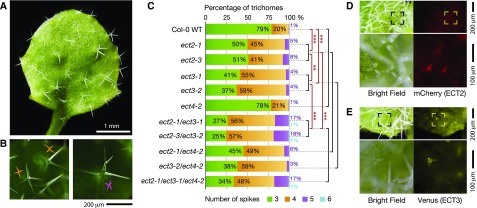Figure 4.
Aberrant Trichome Morphology in the Absence of ECT2 and ECT3.
(A) Young leaf with several trichomes showing an increased number of branches. The picture shown is of an ect2-1/ect3-1/ect4-2 triple mutant, but ect2/ect3 double mutants exhibit the same branching pattern.
(B) Examples of trichomes with aberrant branching. Left, four-spiked trichomes marked with orange symbols; right, five-spiked trichome marked with a purple symbol.
(C) Branching pattern sorted by number of spikes in the indicated genotypes. Branches were counted on at least 150 trichomes on each of at least 6 plants for each genotype (n = ∼1000). Seven observations of two-spiked trichomes and one observation of a seven-spiked trichome were removed from the total of >12,000 trichomes counted for simplicity. Percentages corresponding to three and four spikes are overlaid on the green and orange colored bars, while percentages of five and six spikes, if any, are indicated to the right of the bar in purple and cyan numbers, respectively. Data were fitted to a proportional odds model in R for statistical analyses as described in the Methods. Asterisks indicate Bonferroni-corrected P values: **P < 0.01 and ***P < 0.001. Black bars indicate no significant difference.
(D) and (E) Fluorescence microscopy images of young trichomes in plants expressing ECT2-mCherry (D) or ECT3-Venus (E). Framed areas on upper panels are magnified below.

